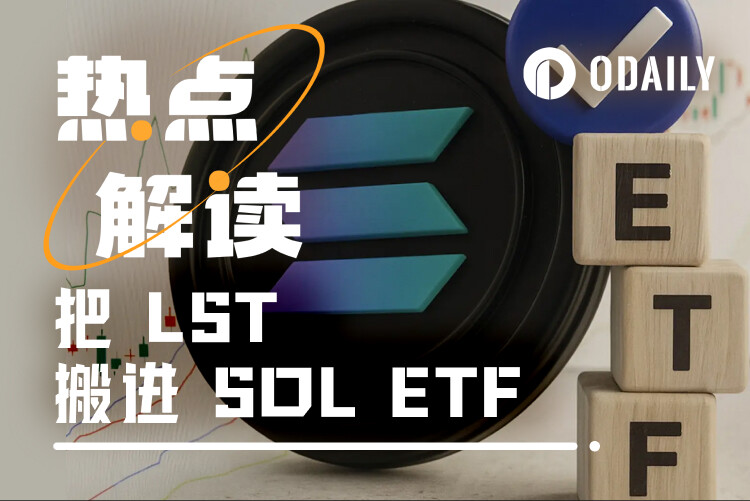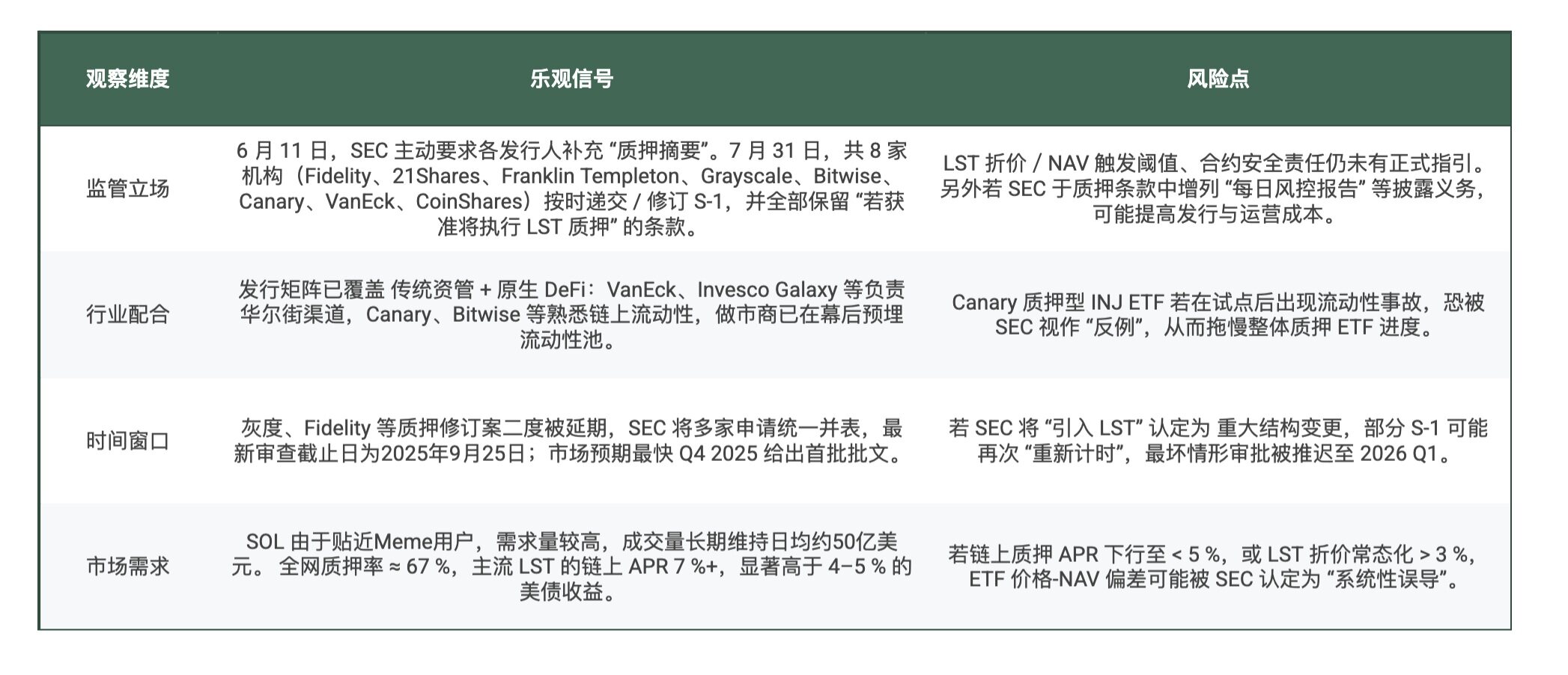Bringing LST to Wall Street: Solana ETF's "Staking Hack" Campaign
- 核心观点:SEC态度反转,Solana质押ETF或成现实。
- 关键要素:
- SEC要求补足质押条款,暗示放行可能。
- 8家机构提交修订版S-1,质押成核心。
- LST进ETF或提升Solana质押率至71%。
- 市场影响:推动PoS资产合规化进程。
- 时效性标注:中期影响。
Original | Odaily Planet Daily ( @OdailyChina )
Author | Ethan ( @ethanzhang_web 3 )
On May 20 of this year, the SEC pressed the pause button for the first time, requiring 21 Shares, Bitwise, VanEck and Canary Capital 's spot Solana ETF to wait a little longer - the reason being that "more time is needed to evaluate legal and policy issues."
Less than a month later, the tide suddenly turned. On June 11th, multiple sources familiar with the matter revealed that the SEC had verbally notified all potential issuers , stating that they must submit a revised S-1 within the next week and provide their comments within 30 days . The SEC specifically requested additional descriptions of "in-kind redemption" and "pledge," clearly implying that "pledges are negotiable."
Soon, large asset management companies responded collectively: six institutions including Franklin Templeton, Galaxy, Grayscale, VanEck, and Fidelity submitted updated versions of S-1 on June 13-14; the term "Staked ETP" appeared for the first time in the SEC's trace document, and pledge became one of the chapter titles.
On June 16, CoinShares joined the battle and became the eighth applicant; on June 24, Grayscale wrote down a 2.5% management fee rate in the new version of S-1, using "high fee + high brand" to bet that it would be the first to pass.
Entering July, the pace of SOL ETF has clearly accelerated:
- July 7th – CoinDesk revealed that the SEC set a hard deadline of “end of July submission” in order to approve the first batch of spot SOL ETFs before October 10th .
- July 8 – Fidelity application was delayed 35 days “pending additional documentation”;
- July 28th — Grayscale applications are postponed again, with the new deadline falling to October 10th;
- July 29th — Cboe BZX filed two 19b-4s at once: ① Canary Staked INJ ETF; ② Invesco × Galaxy Spot Solana ETF , clarifying the "spot + staking" dual insurance;
- July 31st - ① Jito Labs + Bitwise + Multicoin + VanEck + Solana Institute submitted an open letter to the SEC Crypto Asset Task Force, officially advocating for "Staked ETP"; ② 21 Shares simultaneously submitted a revised S-1 on the same day, completing the pledge terms at the last minute (see SEC archive documents).
At this point, the back-and-forth of "two delays + three rounds of revisions + four new applications" has been completed in two months - pushing the core issue we are going to discuss today to the forefront: Is it feasible to include Liquid Staking Token (LST) in an ETF?
Why: Why do LSTs desperately want to enter ETFs?
LST List and Current Status

Note: APR is the data from the official website of each LST issuer on August 1. This data will change in real time and is subject to actual presentation.
Triple benefits
Passive funds = long-term lock-up
The larger the ETF, the more it can transform LST into a pool of funds where investors can earn continuous returns without any intention of reducing their holdings. For Jito and Marinade, this directly adds billions of long-term stake, allowing the protocol to maintain stable commissions and naturally boosting TVL.
Deep jump in liquidity
The ETF will continue to change hands in the secondary market, and the LST corresponding to the fund shares will require daily subscription and redemption to make markets. Market makers will simultaneously build the depth of LST/SOL and LST/USDC , providing LST with a thicker bottom than the DeFi pool.
Brand credibility spillover
Entering the SEC compliance framework means being "endorsed by Wall Street." Once the JitoSOL/mSOL name begins appearing in public documents like I/Os and N-CSRs, the cost of due diligence for ordinary institutions plummets, and LST is upgraded from a "niche DeFi credential" to a "recordable financial asset."
What is the impact? Three main lines of analysis
Solana: Security + Valuation Double Improvement
- The pledge rate will increase - based on the data from H1 2025, if the first batch of spot SOL ETFs raises a total of US$5 billion and 80% is allocated to LST, the chain will have an additional 24 million pledged SOLs (based on 167 USD/SOL) at one time, and the pledge rate will increase from 66% to nearly 71%, and the network's Nakamoto coefficient will also rise.
- The valuation anchor "yield" —a staking APR of ≈ 7%—has become a segment of the DeFi risk-free yield curve. Buyers can use a simplified discount of "SOL current price / 7%" rather than a pure beta parabola, which is more valuable for the sector.
For other ETFs:

Conclusion: If the SOL LST ETF passes first, the ETH camp will be forced to write more detailed "native staking" clauses, and the BTC ETF can only continue to rely on lowering fees to maintain its attractiveness.
For buyers of ETFs:
- Get three benefits with one ticket - spot beta + 7%+ annualized return + secondary market liquidity; for accounts with heavy compliance constraints such as Family Office/pension funds, this is the first "high-yield PoS ticket you can buy".
- Tax & Settlement Friendly - Staking income is often taxed as capital gains rather than operating income in the 40 Act/33 Act structure, which is better than personal on-chain staking.
- Fee wars —currently disclosed fees range from Grayscale's 2.5% to an expected 0.9% (industry speculation stems from the VanEck framework). Whoever offers the highest returns will attract orders . Bitcoin ETFs have already seen fees swell to 0.19-0.25%, and the fee war is poised to spread.
Is the appeal strong enough? What are the risks?

Based on the above data, the probability of passing the review is approximately 60-70%. At the same time, the author believes that in order to successfully pass the review, the issuer should provide at least three types of response plans in the S-1:
Option 1: Discount Circuit Breaker Threshold
It is recommended to set an upper limit for the deviation of the LST market price from the reference NAV (for example: ± 5%); once the threshold is reached, primary market subscriptions/redemptions are suspended and a "spread adjustment" or cash creation backup process is initiated to ensure that fund shares remain aligned with the value of the underlying assets.
Option 2: NAV calculation and calibration
At least two independent data sources should be introduced: an on-chain oracle (such as Chainlink) + a compliant custodian/market maker (such as Coinbase Prime, Cumberland, etc.); 10-second updates are recommended, and redundancy and failover plans should be disclosed to facilitate regulators to assess price distortion risks.
Option 3: Contract Risk Coverage
At the smart contract level, in addition to annual third-party audits, you can consider purchasing Lloyd's of London, Nexus Mutual , or equivalent insurance policies to cover extreme situations such as hacker attacks and collateral penalties; and clearly state the claims process, insurance limit, and trigger conditions in the prospectus to allow investors and regulators to have quantitative expectations of potential losses.
(Note: The above measures are a “reference framework” proposed by the author based on public cases and common industry practices. Specific thresholds and technical routes still require further communication and determination between the issuer and the SEC.)
Conclusion
From "blacklisting" in May to "promoting" the launch in July, the SEC reversed course in just 70 days: no longer dwelling on "whether" to list, it began discussing "how"—for the first time, the footnotes to "Crypto ETF 2.0" included staking and LST. Meanwhile, on the other side of the table, crypto players, with "an open letter and a revised S-1," told Wall Street: "We understand maximizing capital efficiency better than you do." The next step depends on whether regulators are willing to allow this "high-yield, low-maintenance" staking game to truly enter retirement funds and 401(k)s.
If it is really released, it will not only be a victory for Solana, but also a milestone for the PoS narrative to move from the chain to the exchange and from geeks to institutions.



